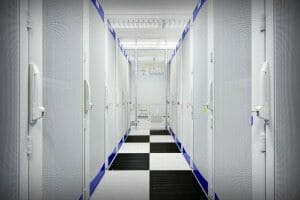5 Ways Stranded Cooling Capacity Impacts Your Data Center8 min read

The most costly form of stranded capacity is stranded cooling capacity, which is any portion of the mechanical system that is running, but not contributing to cooling IT equipment. The impact of stranded capacity is wasted cooling energy (and consequently money). However, just because you can’t see the problem doesn’t mean it isn’t there. With this in mind, here are 5 facts you need to know about stranded capacity to understand how it’s harming your data center.
1. There is more stranded capacity in most data centers than you might think.
Of the last 45 sites evaluated by Upsite, the research clearly uncovered that there was 3.9 times more cooling capacity than IT load. This represents a great deal of fan horse power running unnecessarily and premature capital expenditure for cooling units that were not needed.
2. Low cooling unit temperature set points can strand capacity.
Manufacturers rate their cooling units on standard return-air conditions, typically 75 degrees (F) with a 45 percent relative humidity (RH%). However, since most sites run their cooling units with set points lower than standard conditions, the rated capacity cannot be delivered. This results in the very costly condition of more cooling units running because the cooling unit’s cooling capacity decreases at lower return-air temperatures.
For example, a common 20-ton (70 kW) cooling unit has 20 tons (70 kW) of total capacity at a 75-degree (F) return-air temperature and 45% Rh. Conversely, at a 70-degree return-air temperature and 48% Rh, the same 20-ton cooling unit has a sensible cooling capacity of only 17 tons (59.7 kW).
3. High relative humidity can strand capacity.
In some IT configurations, high relative humidity (RH%) can result in condensation forming on cooling unit coils (i.e. latent cooling). Moisture condensing on cooling unit coils actually gives off heat that consumes some of a cooling unit’s cooling capacity, stranding capacity that could otherwise be used to reduce the air temperature of the supply air to IT equipment.
4. Misplaced perforated tiles can strand capacity.
Misplacing perforated tiles in your computer room strands cooling capacity. For example, locating perforated tiles or grates in an open area or hot aisle allows valuable conditioned air to leave the raised floor plenum. The volume of air lost through these tiles is not available to cool IT equipment. This unused conditioned air is stranded capacity.
5. Unsealed cable openings can strand capacity.
Similar to misplaced perforated tiles, unsealed cable openings release bypass airflow that strands cooling capacity because the conditioned air escaping through these cable openings and can no longer be used for IT equipment.
As you can see, there are potentially numerous sources of stranded capacity in a data center. By themselves, they may account for a large percentage of the sites cooling capacity. Added together, they can amount to a substantial waste of resources and money, so all must be addressed to properly optimize the cooling efficiency and capacity of a room. Reducing stranded capacity will maximize both the potential load that can be cooled effectively and the savings that can be realized by making essential airflow management (AFM) improvements.
Stranded capacity can be recovered without spending loads of money. All that must be done is basic—yet effective—room airflow management and controls adjustments. These simple steps will recover stranded capacity and lead to energy savings.

Airflow Management Awareness Month
Free Informative webinars every Tuesday in June.
0 Comments